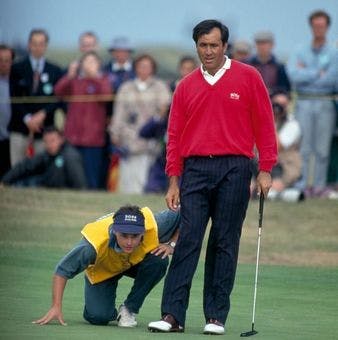Seve Ballesteros

He was born on April 9, 1957 in Pedreña (Cantabria), a small village on the south coast of Santander Bay in northern Spain.
Seve did not have much chance to play at the Pedreña (Golf Club and for that reason he sharpened his skills mainly on the beach and only on nights with a full moon did he tiptoe down a play the course. Of course, he was caught our more than once and punished for his misbehavior, which made him think seriously about his future.
Despite these obstacles, on 22 March 1974 he turned professional (he was not quite 17). His first tournament was the Spanish Professionals Championship at San Cugat. He came 20th, causing his great disappointment as his objective was no less than outright victory. His first triumph came in Pedreña when he won the under 25 Championship of Spain and the following week he was runner – up at the Santander Open, al the North of Spain Circuit. At an international level, his best performance was at the Italian Open where he came 5th.


Seve’s fighting spirit was most likely inherited from his father and it has become a characteristic of his in all he does, whether on or off the course. He has fought to dignify the European tour and this cost him no small upsets such as, for example, not being selected to play in the 1981 Ryder Cup. Despite all, his contribution has been vital in bringing the event to the brink of expectations and making it become one of the most keenly-followed sporting events shown on television.
To talk about world golf was to talk about Seve and, for this reason, when he refused to play exclusively on the American Tour; the issue was taken up with the top mandatory circles of the all-powerful US PGA Tour, resulting in an historical change of ruling.

During the first edition of the Seve Ballesteros Trophy in April 2000 in England, he showed his incomparable virtues when playing various types of shots. His talent helped him win Colin Montgomerie, captain of the United Kingdom and Ireland team.
His activity as a golf course designer through the company Trajectory is internationally recognized. He has designed more than thirty fields in several countries, from Spain to Japan, through France, England, Switzerland, USA, Scotland, the Philippines, Ireland, Portugal or Thailand.
In October 2008, the Times, the UK's leading newspaper, selected Seve as the first on a list of athletes who have changed the way we view sport.
His intense activity as a golf course designer through his company Trajectory, is internationally recognized. He has already designed more than thirty courses in several countries (Spain, Japan, France, England, Switzerland, the USA, Scotland, the Philippines, Ireland, Portugal, Thailand…).
In October, 2008, The Times, the most important and prestigious newspaper in GB, selected Seve as the first one in a list of athletes who has changed our point of view about sports.
On October, 5th, 2008, Seve had to be admitted as a matter of urgency at La Paz Hospital in Madrid, after suffering a collapse. A brain tumor was diagnosed and he had surgery on October 14th.As a result of the intervention he suffered a brain edema. On the 24th of the mentioned month, he had surgery again to act on a hematoma located inside his brain. On December 2nd, he returned to the operating room.
Since being discharged from hospital, Severiano followed a very tough recovery program which he only interrupted to give his time to the Seve Ballesteros Foundation which he set with the aim of funding investigation on brain tumors coordinating it with his work as golf course designer.
On May 7th 2011 some minutes after two o'clock in the morning Seve Ballesteros passed away at his home in Pedreña with his close family at his bedside.
